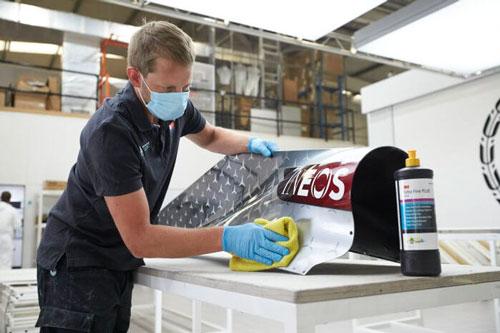Return to Racing - What the 'New Normal' looks like for F1 Teams
| Author: Bradley Lord | Published: 20th June 2020 12:31 |
 Return to Racing - What the 'New Normal' looks like for F1 Teams
Return to Racing - What the 'New Normal' looks like for F1 Teams With the 2020 F1 season about to start in two weeks' time, the Mercedes-AMG Petronas F1 Team provides some insights into the work performed behind the scenes to prepare for a safe return to racing following a 63-day shutdown period due to the COVID-19 pandemic, the Mercedes-AMG Petronas Formula One Team returned to work in early June, preparing to go racing again while observing protocols and procedures that have become the 'New Normal'.
What measures have been taken to ensure safe working conditions at our F1 factories?
Both Mercedes F1 Technology Centres in Brackley and Brixworth went through a social-distancing makeover before the end of shutdown to ensure that our staff could return to work safely. Before team members were allowed back on site, each participated in an online induction to familiarise themselves with the new guidelines. Now, when our colleagues arrive at the factory, their temperature is checked to ensure that they don't have a fever. Signage has been added around the factory to remind staff of the hygiene and social distancing protocols, but also to mark new one-way systems which have been put into place in many areas of the factories - such as hallways, corridors, staircases and walkway routes around offices and manufacturing floors. The ventilation system is running at full capacity to ensure that the maximum number of air changes per hour possible is provided. In areas where the work performed does not permit social distancing, as well as whenever colleagues move around the facility, they are required to wear face masks. Employees must practice hand hygiene and are also required to wipe down workstations before and after work and when taking breaks. Face masks, gloves, disinfectant wipes and hand sanitiser are available throughout the factory to make complying with the new protocols as easy as possible. At the same time, the factory is still relatively 'empty' with about half of the workforce working from home. The team members working from the factory are those whose jobs require their presence on-site, for example, needing access to certain machines or tools.
What have some of the challenges been?
One of the biggest challenges was making sure that a large percentage of our employees were able to work from home. Previously, the peak number of MGP employees working from home at the same time was around 70. Now, we reach peaks of about 450 people. This created a number of challenges, particularly for our IT department which had to ensure our team members could work from the safety of their own homes. At the same time, changing the protocols of an entire factory was not an easy task, particularly for those areas that worked on Project Pitlane during shutdown and were thus still in operation. There were a lot of aspects to consider - from installing thermal scanners at various locations throughout the factory to finding the safest way of distributing food in the canteen.
What are the new protocols and procedures trackside?
To ensure high health and safety standards and to protect our team, the entire trackside team was tested for COVID-19 before they were allowed to attend the two-day test at Silverstone. At the track, social distancing rules are enforced wherever possible; in addition, the team is required to wear masks. Some roles also require face shields or other additional personal protective equipment. Hygiene protocols include hand washing and sanitising practices, but also the regular cleaning of workstations and equipment with disinfectant. The measures practiced by the team at Silverstone will be similar to the those at races, including regular testing for COVID-19 for all trackside personnel. Teams will also keep their distance from each other, creating 'team bubbles' to limit the risk of exposure amongst the teams. Further, as only essential team personnel will be attending the races, the number of team members at the track will be lower than usual. Owing to the fact that team partners and guests will not be granted access to the track either, teams will be travelling without their motorhomes and instead use the infrastructure at the track for the provision of meals.
How important was the two-day test at Silverstone for the team?
Being able to run through the new procedures and protocols in advance of the first race was an invaluable experience that yielded plenty of learnings - from adopting working in face masks and other personal protective equipment to reassessing the garage layout. It gave all trackside personnel the chance to familiarise themselves with the new way of working in the garage and was an important step to ensure a smooth operation once the season begins.
What impact will the revised calendar have, from the team's perspective?
That depends. From an engineering perspective, the effect is smaller than one might imagine. F1 teams aim to design cars that work well at any track, so a revised calendar shouldn't throw up many curveballs with respect to the car itself or its development programme. But there will be some differences due to the fact we will be going to tracks at different times of the year which will have an impact on track and particularly ambient temperatures. However, the revised calendar has a much bigger impact on the trackside operations of the team. Triple headers are very demanding for the team as there's less time between events to service the car. It will also be more intense on those trackside team members with many spending longer stints away from home and having to stay in the team's bubble. However, if the atmosphere at the two-day test in Silverstone is any indication, the entire trackside team is just buzzing to go racing again soon.
Do the shutdown and the revised calendar impact the development of the car?
During the 9 weeks of shutdown, F1 teams were not allowed to develop the car. However, the design of the W11 taken to Australia was frozen around Christmas - owing to the lead time required for manufacturing and testing various components - meaning the team had already developed the car for some three months before the shutdown started. In other words, at the time the car was going to hit the track in Melbourne, we had already found a bit of extra performance in the wind tunnel and in our simulations. Other teams will have had similar experiences and all competitors will now try and get as much of that performance as possible on their cars for the first race in Austria.
Report this article as inappropriate
Comments
You need to log in before you can do that! It's only a quick registration process to join the AMA network and completely free.



 Help
Help

 Loading...
Loading...


 Help
Help